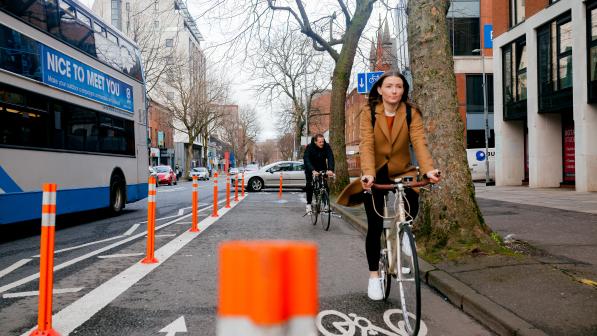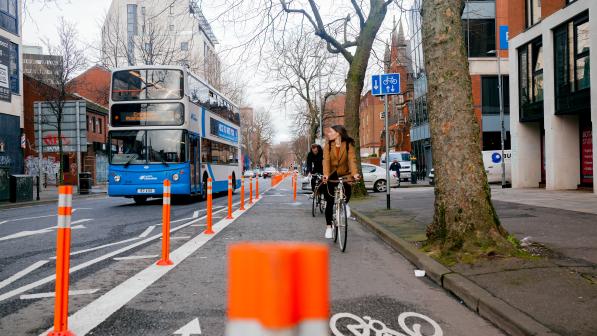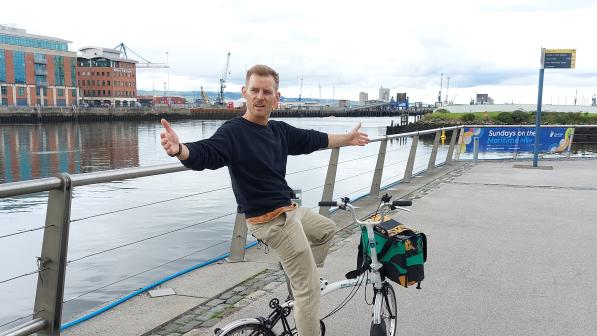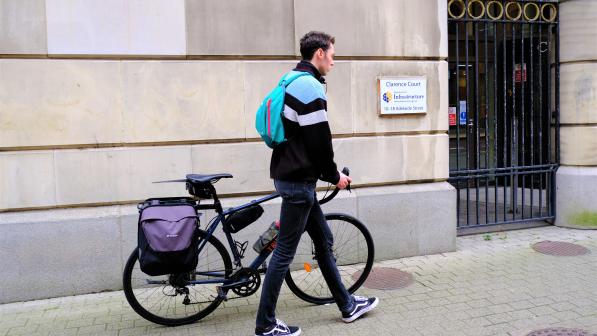Northern Ireland All Party Group launches enquiry into cycling numbers

The All-Party Group (APG) for cycling has been in place at Stormont since 2011. For the past year, Cycling UK has sat as joint secretariat of the group alongside Cycling Ulster.
In the absence of an assembly, government progress remains slow on cycling. The APG has not been idle, though, and with Cycling UK support has met with relevant bodies across the private and public sector, hosting Translink, the Police Service Northern Ireland (PSNI), the Department for Infrastructure and leaders across the business community.
The purpose of this is to hold these bodies to account on cycle provision and safety and to ensure cycling remains a key part of their agenda for progress.
The mini-inquiry
The APG chair has now commissioned an enquiry to explore short- and medium-term measures which have been shown to increase the number of people cycling and improve cycle safety.
In October the group was delighted to host a range of speakers at the APG which focused on two of the measures put forward for the inquiry: 20mph speed limits and changes to the NI Highway Code.
The panel consisted of Wales’s Deputy Minister for Climate Change Lee Waters, architect of the 20mph rollout across Wales. He was joined by Alan Tapp from the University of the West of England and Phil Jones who chaired the task force for Wales’s 20mph rollout.
It also hosted Cycling UK’s head of campaigns and advocacy Duncan Dollimore to speak on the 2022 changes to the GB Highway Code, which are yet to be considered in Northern Ireland.
20mph rollout across Wales
Wales’s countrywide rollout of a default 20mph speed limit will likely go down in history as a rare example of a UK politician in this era putting their head above the parapet and sticking to their principles in the face of media and public criticism.
It is a monumental achievement in legislation which will save lives, support the shift of people from their cars and make Wales a more pleasant place to live and visit. Like any major project it has not been easy, and the APG scrutinised the panel on some of the decisions made through the process.
Why a countrywide default rather than piece by piece?
This was one of the main questions to the experts from the APG: why not select streets and areas where 20mph makes sense rather than go for a countrywide default limit?
The (very good) reason is that doing it piecemeal would require signage across the region and would become a tediously time-consuming process to get approval for each area.
National government in Wales has always had the power to set default speed limits for types of roads, and local authorities have (and still have) the power to exempt certain roads and areas.
Deputy Lee Waters put this very succinctly when he said: “We turned the current system on it’s head; where before the default was 30mph and councils had to make a case for a 20mph limit, now the default is 20mph and the council needs to make a case for 30mph.”
What about public opinion and backlash?
It is not often that Wales (or Northern Ireland) makes the front pages of national UK newspapers, but as the 20mph rollout approached in Wales there were many publications leading the resistance to the change.
Inevitably public opinion followed leading to the ‘most signed petition in Senedd history’ opposing the change.
This would send fear through the spine of many political leaders. Lee, however, along with other proponents of the scheme are confident that public opinion will follow the well-charted ‘Goodwin curve’.
This predicts that attitudes towards congestion-reduction schemes are generally supportive before implementation (in this case 80% support!), but gradually decrease the closer the scheme gets to intervention, hitting its lowest before, during and right after the change is in place.
The good news for the minister is that Goodwin showed how after a scheme has become embedded public support rallies to pre implementation (or higher) levels. If this turns out to be the case in Wales, it will become a strong lesson for our political leaders to learn about bold decision-making and backing proposals that make our roads safer while supporting better transport choices.

2022 GB Highway Code changes
The group was also joined by Duncan Dollimore, who led Cycling UK’s work on getting the Highway Code updated to make the roads safer for cycling introduced across Great Britain in January 2022.
Duncan focused on two key aspects of the changes: the ‘hierarchy of road users’ and the new rules at junctions, making the argument that the Department for Infrastructure should be consulting on these changes now to make ready any proposals for a future minister to take forward.
Hierarchy of road users
The GB Highway Code now officially recognises a clear hierarchy of responsibility on our roads, with those driving the heaviest vehicles having most responsibility, down to people with disabilities and people walking being the most vulnerable road users.
As Duncan pointed out: “Everyone has some responsibility for their own safety, but the consequences of our actions are not equal.” The new approach is proportionate and “establishes the point that your responsibility is framed around the risk you pose to others”.
Junctions
The new rule around junctions is a little harder to explain, but its elegance is that the GB Highway Code has replaced 14 junction rules with just one. This is very much in line with other European nations which have had this rule for much longer. Again, Northern Ireland lags behind in this regard.
Our Highway Code is a catalogue of misunderstood or completely unknown set of junction rules, yet again leaving more vulnerable road users with greater level of responsibility that someone driving a car.
Duncan concisely explained the new rule as: “The person/vehicle which is continuing straight on is now the one that has priority over any vehicle turning.” Therefore a car driver turning left along a road has an obligation to check anyone crossing the junction on their near side or any cyclist passing.

What next?
All the experts agreed that these changes are all important, but none is a silver bullet: they must be put in place alongside many other key interventions.
The other place of agreement is that every measure is going to take time to embed, as Duncan Dollimore said about the Highway Code: “It was never going to be the case that because the Highway Code was changed on 30 January 2022 the roads were suddenly a miracle place for everyone to the next day.”
The takeaway from this APG is that we know what we need to do to realise greater transport choice, but we need our leaders to be bold, face the criticism, listen to it, and then make changes in order to bring the public with them.
If we do this, we can make transport across Northern Ireland safer and more equitable for all road users.
Cycle campaigning
We campaign on a wide range of issues to make cycling safer for everyone and enable more people to cycle more often.
Help support our campaigns and together we can achieve real change for cyclists, securing funding for cycle lanes and routes, making our roads safer and improving access to the outdoors.



